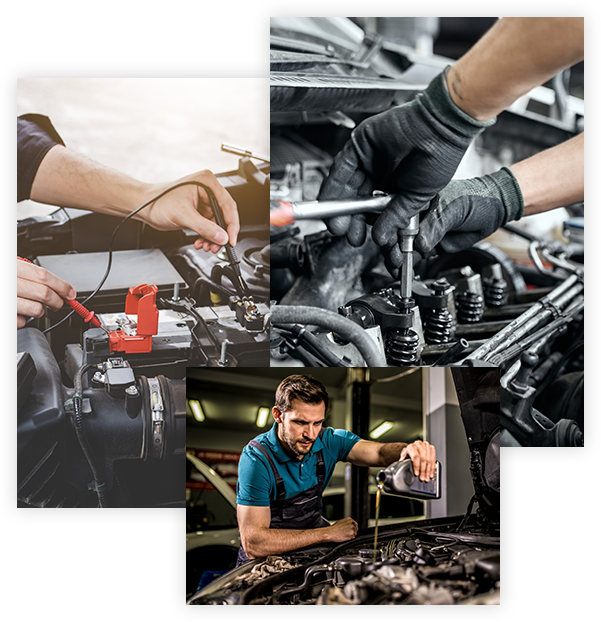Tips & Advice

Why have an ASE Technician work on your vehicle?
ASE certification takes the guesswork out of finding a good technician. The independent, non-profit National Institute for Automotive Service Excellence (ASE) tests and certifies the competence of individual automotive repair technicians so you can be assured of their skills and knowledge.
Proven Experience, Skills and Knowledge
To become certified, technicians must pass at least one of ASEs 40-plus difficult national exams and provide proof of two years of relevant work experience. Prior to taking ASE exams, many technicians attend training classes or put in hours of study to prepare.
Changing Technology
Today’s complex vehicles demand current technical knowledge. ASE requires technicians to re-test every five years to keep up with technology and to remain certified. All ASE credentials have expiration dates.
Recommended Service Intervals:
Each manufacturer has compiled a list of recommended service intervals. For details, just look in your owner’s manual. Each make and model has different recommendations, but here are some general guidelines:
-
Oil/filter change and safety inspections are recommended every 7,500 miles.
-
Minor service is recommended every 15,000 miles. At a minimum, this consists of an oil/filter change, a safety check and fluid check.
-
Major service is recommended every 30,000 miles. This can include changing the oil/filter, spark plugs, gear oil or transmission fluid, air and fuel filter, flushing some or all fluids and adjusting valves (unless hydraulic).
Listed below are a few other benefits to keeping your car serviced at scheduled at scheduled intervals:
-
A regularly serviced vehicle will last 200,000, 300,000 and possibly 400,000 miles.
-
A misfire can cause up to 50% less fuel mileage and a major increase in harmful emissions.
-
Improper tire inflation wears tires faster and wastes fuel because the engine has to labor harder to move the vehicle.
-
Improper tire alignment can wear out your tires more quickly.
The more timely vehicle servicing you do, the more money you save in the long run.
The longer you wait until you service, the harder your car has to work. Cars suffer carbon build up, dirty fuel injectors, and dirty throttle bodies. City driving is especially hard on cars. Fuel filters get plugged causing the pump to labor harder. This creates a domino effect on everything from the spark plugs to the transmission. Waiting doesn’t make sense.
The Importance of Changing your Oil
Changing your oil regularly is the single most important service you can do for your car, and it’s one of the easiest. Oil is produced to conform to the needs of your car; it’s the life of the engine. Dirty oil creates leaks, scored bearings and over consumption. You can never change it too much but it’s recommended at every 3,000 miles.
-
To see what kind of oil you need, look in your owner’s manual, the lid of the oil cap, or ask the sales person in an automotive parts store. Most modern engines require SW/30 or 10W30.
-
For performance or air cooled engines, you might consider 20W/50.
-
Most name brands are acceptable and do a super job when changed every 3,000 to 4,000 miles. Be sure to change the filter at each oil change.

Synthetic oil's advantage is that it withstands higher temperatures. Synthetic oil lasts about twice as long as conventional oil, which lets you travel twice as far between oil changes. However, synthetic oils cost about twice as much.
- Synthetics are recommended in extreme hot or cold conditions.
There are a number of fluids that can leak from your vehicle, with many of them leading to a possible breakdown and expensive repair if neglected. Remember, your vehicle is a machine. Becoming familiar with your machine regarding the type of fluids it requires to operate properly will help you know what kind of fluid leak that you might be experiencing and what system that may be affected by the leak.
Some leaks are obvious, where others may play hide and seek with you. Knowing what to look for and where to look can help you avoid a costly repair, as long as you find it in time. Below are some helpful hints as to the type of fluids used in todays vehicles, as well as various colors and other characteristics to help you identify them.
Tip: If you can't find the location of the leak on your vehicle, place fresh newspapers under where you think your leak is overnight and then check them in the morning. Bring your vehicle and the newspaper with the fluid to us for help in locating the leak.
Engine oil is typically dark-brown or black in color. At times, you might see a few drops here and there and this might be all right if you recently have had your oil and oil filter changed or performed this service yourself. This can largely be attributed to the location of the oil filter on the engine and some old oil may have dripped upon some of the vehicle chassis or a small about was spilled onto the engine when dispensing the new oil into the filler area. While a few drops shortly after an oil change might be okay, you want to make sure that puddles of oil do not occur.
Engine antifreeze / coolant can be either green, yellow or red depending on the type used by the vehicle manufacturer. Most vehicles have a radiator located just behind the grill. This fluid has a sweet smell to it. Not enough antifreeze / coolant will cause the engine to overheat. There is usually an overflow or fill tank where you can add antifreeze / coolant to your cooling system. Using just water reduces the heat.
Brake fluid is generally clear and oily to the touch. When you depress the brake pedal, brake lines allow the brake fluid to be pushed through to each of the four wheels containing a stopping device, either a brake caliper or a wheel cylinder. So any number of leaks could appear almost anywhere a weakness may exist in the system. While leakage of the brake system is rare, you would likely feel a soft or spongy brake pedal feel when depressing the brakes, which can lead to brake failure if not correctly immediately.
Transmission fluid is typically red, although the color can be a milky-pink color if it becomes contaminated. Some transmission fluid of certain vehicles may be clear or amber in color. If you have a front-wheel-drive vehicle, then your transmission is next to the side of your engine underneath the hood. If you have a rear-wheel-drive vehicle, then your transmission is located in the center of your vehicle just under the dash under that hump in the center. If the color of your transmission fluid appears to be brown, then this would indicate that the fluid has overheated and should be changed as soon as possible.
Power steering fluid is generally red, although some vehicle manufacturers may use a fluid that is almost clear or amber. The power steering reservoir is typically mounting with the power steering pump driven by a belt on the engine. Leaks generally occur within the power steering lines.
Pink or blue fluid would indicate that your windshield washer reservoir is leaking. For the front windshield, this reservoir is under the hood in the engine compartment. For vehicles with rear wipers, its usually mounted behind a panel in the rear left or right side of SUVs and Vans.
Gasoline is a clear fluid with a strong smell and is obviously highly flammable. Gasoline is stored in the gas tank usually located at the rear of your vehicle. Leaks can occur if you bottom out your vehicle, causing damage to the gas tank. There are also fuel lines that run underneath the vehicle up to the engine. Leaks can also occur within the fuel line (rare), but are most likely to occur at a connection points. Gasoline leaks should be repaired immediately due to a fire hazard.
Diesel fuel looks like light oil. While not as flammable as gasoline, it can ignite in the right conditions. Leaks should be taken care of as soon as possible.